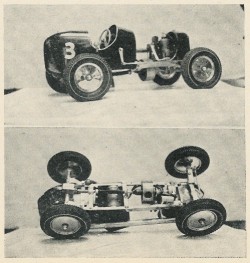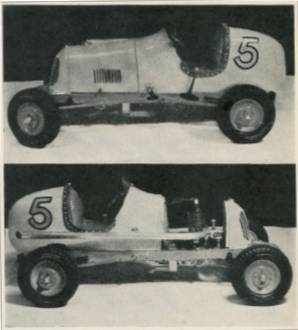

In the earliest beginnings -- Racing of miniature cars powered by gas airplane engines started in California around 1937. In the beginning the cars were home built with ashtray tires and primitive parts. They could reach speeds of around 40 MPH. Soon clubs started to form, rules were drafted, tracks were spawned, and events planned. The earliest cars were lovingly modeled to appear authentic with windshields, seats, steering wheels, gages and sometimes even little drivers. |
 |
 |
Pre-War -- Manufacturers started to spring up and produced both kit cars and factory built ready-to-race cars. These cars were expensive for the day considering the depression had just recently ended. Most factory built cars sold for around $20 - $30 with the most expensive being the B.B. Korn selling for $53.50 in Magnesium form. Kit cars sold for as low as $10. Prior to the war, cars reached speeds in the mid-70s for Protos and 100 MPH for cable streamliners. |
War time -- Unfortunately, the hobby suffered like so many others during the second World War. Most manufacturers went out of business because metals were shifted to the war efforts. To my knowledge, The Dooling Bros. were the only one notable manufacturer that resumed operations after the war.
Post War -- After the war ended, manufacturers began to spring up once again. Because of the war, there were new, light-weight materials to work with such as plastics, and fiberglass. Most cars began to take on more streamlined looks and began to reach speeds of 100+ MPH.
The End -- It has been said that the hobby came to a close due to the lack of fan participation. The cars had become too fast and the fans could not longer view them. The cars also lost their appeal when they took on a more streamlined appearance and no longer represented the real midget race cars of the day.
